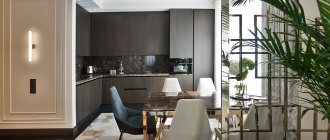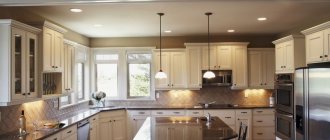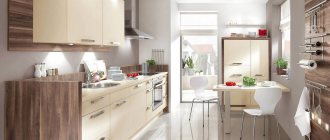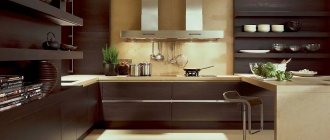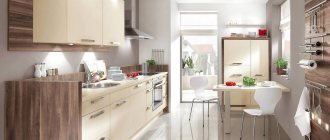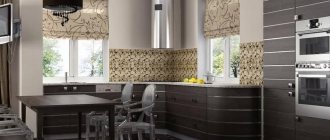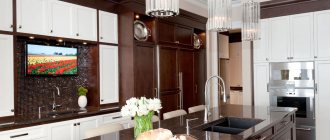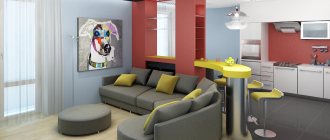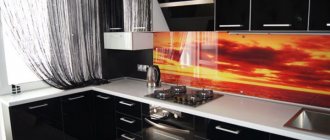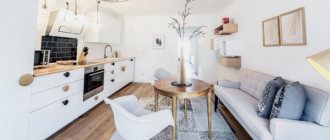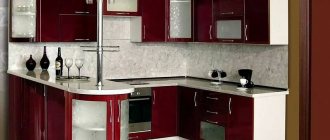Olive cuisine is a universal combination. Anyone can create a unique design with its help: from an amateur to a professional. A few basic rules - and an impressive result is guaranteed.
Olive is a classic for the kitchen interior. This color is otherwise called “gentle khaki”. Depending on the tonality, it allows you to create interesting and aesthetic combinations.
Peculiarities.
- Color base. Olive is a muted shade of green with the addition of yellowish and khaki tones. This allows you to use it as the basis of a palette with any basic shades.
- Versatility. Depending on the additional colors, it can be used to achieve any mood in the kitchen: from warm and joyful to calm and melancholic.
- A proven classic. Olive in kitchen design is a time-tested option. Many ready-made solutions and projects have been created with this color.
- Ease of use. Even a non-professional will be able to implement real masterpieces of design in their kitchen. The color is easy to apply. It's hard to go wrong with him.
- Compatibility. Olive, along with black and white, is an ideal base for any shade. This is a unique color. It harmonizes with all shades.
The main feature is the naturalness of olive. The combination of mustard tones and muted green gives a feeling of closeness to nature and creates a peaceful mood.
It can be used in two versions. First: olive - basic, occupies 60-70% of the color space. Second: olive acts as an additional color.
Choosing a style
This is one of the most versatile colors that can be confidently used to create any style. Olive cuisine can be subtly refined, expressively bright, and ultra-modern: you just need to use the intensity of the desired shade and take into account the color rules for a harmonious combination of colors.
Olive color will look perfect in the interior of a kitchen decorated in a cozy country style or elegant Provence style. For a rustic style, choose soft, pastel shades.
Rich and rich tones accompanied by shiny chrome accessories will become a colorful addition to a fashionable high-tech interior.
The combination of olive and beige can be successfully used both in a classic kitchen and indoors, with a design in a laconic and restrained minimalist style.
Solemn classical interiors in the Baroque or Empire style require a contrast of olive with deep shades of brown (chocolate, coffee), which is usually emphasized with gold (fittings, lamps and/or embossing on wallpaper).
Olive and white kitchen
Olive plus white – luxurious minimalism. The advantage of a minimalist white-olive kitchen is the opportunity to experiment with design by introducing various accessories.
A few bright floral arrangements and lace fabrics will be enough to add romantic, delicate notes to the interior.
White and olive cuisine can become the apogee of classics. In this case, bright elements are not required, because a few olive tones are enough.
The lack of bright inclusions is easily compensated by simple decorative elements, for example, vases with white fresh or artificial flowers, appliqués and beautiful curtains.
Wall color
If the kitchen walls have an olive tint, then it is better to choose the color of the furniture in light shades: white, beige, ivory. Unpainted wooden facades are also suitable.
Even if the olive color of your furniture is diluted with contrasting color details (countertops, fittings, etc.), you should not make the walls in the same green-yellow color tone. An excess of soft green tones will act as a sedative and a sleep aid at the same time, and in such a kitchen you will always want to sleep, no matter how much coffee you drink.
Colors that can be used without restrictions for walls together with an olive set are white, soft cream, milky, light beige. Moreover, the brighter the olive, the more white there should be.
If your kitchen furniture is decorated with a large number of decorative elements (carvings, accessories), and you do not want the interior to seem too pretentious, decorate the walls with a noble light gray color, which will add rigor and respectability to the interior.
If the windows face north or there is simply a lack of natural light in the room, feel free to use the colors of the solar spectrum for the walls: yellow, orange, diluted red.
Features of olive color for the kitchen
Olive is a more neutral and subdued version of green.
This color gives relaxation, calmness and tenderness. It is also associated with love, trust and spring. However, a rich or bright green color is not always appropriate in a room, and its excess will make the interior too relaxing and depressing. Using olive green is a great solution for green lovers.
Advantages of olive color in the interior:
- Promotes vigor
- Increase your appetite
- Food is better digested in such a room
- Looks environmentally friendly
- Easily combine all colors of the spectrum
- Good for the eyes and soothes the eyes
- Olive surfaces are less colored and less noticeable
Kitchens with olive flowers will always be fresh and tidy. And eating food here turns into a real pleasure.
However, care should be taken when using this color. When there is too much shadow, a room can feel melancholy and melancholy. Too dark and waterlogged colors can make the interior look gloomy and dull.
Olive as the main one
Olive color is great for decorating the following kitchen details:
- Front headphones
- Desk top
- Chairs and sofas
- Curtain
- Carpets or tiles in the kitchen
- Kitchen apron
Important! Don't use the same color for all large parts of the kitchen. It is better to choose a combination of olive and some other color.
The combination of different shades of this color looks colorful. For greater comfort, it is better to choose dark olive tones for finishing the lower parts: floor tiles, facades, carpeting for the dining area and chairs.
And for elements that are located higher, it would be more appropriate to use light colors: for curtains, wallpaper and the facades of wall cabinets.
Olive details
Olive in kitchen details creates softness and well dilutes neutral colors - beige, white or gray. The olive drab kitchen is ideal for those who enjoy a relaxing and meditative meal.
A cream or white kitchen with green elements will create a feeling of luxury and wealth, and will also remind you of the Mediterranean countries.
The main colors of the kitchen can be easily diluted with light green details:
- Stucco molding on the kitchen facade
- Open wall shelves
- Chair cushions
- Sofa cover
- With mats under the dishes
- Vases and other dishes
- Curtains
Important! Olive for details you need to select bright and light shades. Darker options will blend with other colors and create a dirtier feel.
Floor
When choosing the color of the floors, be guided by the rule for creating a harmonious space: the color of the walls and furniture is considered the starting point, the ceiling is made lighter, and the floor is darker.
Flooring (laminate, linoleum) with an imitation of wood texture is convenient and practical, given the frequent cleaning in the kitchen, and will look very natural in tandem with light walls.
When choosing floor tiles, try to find a pattern that will match the color of at least two main shades of the interior. In a kitchen with walls decorated with gray wallpaper, floor tiles with an olive-gray pattern will look very harmonious.
The tile can also be a single color, for example, matching the color of the countertop. In any case, do not forget that kitchen floor tiles must have a rough surface - this is a matter of daily safety.
Repair and finishing
The olive kitchen set itself is an accent and suggests a neutral decorative surface finish.
White, beige, gray and their shades are considered suitable for walls. In large kitchens, it is acceptable to use dark gray wallpaper (graphite, wet asphalt) and even black paint.
For the floor, first choose easy-to-care materials (laminate, linoleum, quartz vinyl, tile). The first three can be imitation natural wood of medium saturation. Tile and PVC tiles are preferably plain or with the texture of concrete (if a combination with gray is chosen).
The ceiling is made white as standard. In small kitchens, a glossy stretcher will look best.
The last question is the apron. The main options for olive kitchen in the interior:
- White. Matte or glossy skins, a classic hog, exclusive white marble - any will look appropriate.
- Black. It is realized using glass, suitable tiles, MDF panels with chalkboard patterns.
- Brown. For example, in the same tone with a wooden tabletop. In stores you can find aprons and tabletops of the same color.
The photo shows a muted shade of olive
Apron
An olive-colored kitchen can successfully “wear” either a calm monochromatic or a bright or even variegated apron. If you are going to make it olive, then let the shade be more intense than the main color of the furniture.
A contrasting apron will look great. But, to create a complete composition, it needs to be supported with additional accessories to match.
If you decide to lay out your kitchen apron from ceramic tiles without a pattern, then a bright, possibly contrasting, grout for the seams will help give it more individuality and expressiveness.
A tile with an image of olive branches can support the theme of the southern coast.
Different interior styles
Olive is ideal for any interior style. First of all, these are standard options from classic to modern.
An olive kitchen in a classic interior will look very expensive, even if it is made of cheap materials. It is better to decorate the walls in such an interior in white or cream tones with stucco and relief.
An option with frescoes and paintings will look interesting. A carpet with elements of an aging pattern will make the interior not only luxurious, but also fashionable.
An olive kitchen in a modern interior will be beautiful with its modest and muted shades. Here it is worth thinking about different lighting and backlight options. Smooth details of regular geometric shapes can be diversified in different tones of this color. An apron made from a mosaic of olive tiles in different tones will look interesting.
Oriental style in the kitchen with such colors will look very unusual. Here it is worth using many decorative details: silver or gold patterns on the facade of furniture, light green niches with lighting, open shelves of ornate shapes and rich curtains with rhinestones.
Olive color will bring southern notes to the Scandinavian style, but at the same time retain the flavor of the north. Traditionally, different textures are used to decorate such an interior: pillows made of pile of different lengths and smooth satin, wooden tabletops, corrugated tiles. Scandinavian style involves the use of different lighting sources, and against the background of olive wallpaper and tiles, sconces and lighting of different brightness will look very picturesque.
Technological high-tech will become more comfortable with the appearance of olive details in the interior. The contrast of matte green surfaces with shiny chrome parts, metal and glass will be interesting here.
As you can see, olive color will add warmth, comfort and luxury to any interior.
Tabletop
The choice of countertops for the kitchen must be approached with special attention and even some pickiness. After all, this is not only a decorative addition to a furniture set, but also a working surface that must withstand considerable loads and is easy to clean.
As for the color scheme of countertops, surfaces that also have a “natural” color go well with olive color. Natural stone or noble wood species will look very harmonious, especially if a similar texture is repeated in some other interior elements.
Countertops in the color of coffee or chocolate, saffron or mustard, plum or eggplant look impressive. A matte surface will dull the visual perception of color, while a glossy surface will make the shade more saturated.
Which countertop to choose?
Recommendations for choosing a table for a work area are the same as for an apron. Most often, white and black plain surfaces with imitation stone are used. In country and other styles that require home comfort and warmth, a light wooden texture would be appropriate.
Gray colors will add rigor and are suitable for both classic and minimalist modern solutions.
Textile
Imagine the most fashionable, stylish and modern kitchen without curtains, beautiful tea towels, oven mitts and other fabric items. Will it be cozy in such a kitchen? Of course not.
Beautiful curtains for the kitchen not only protect us from the bright sun and participate in the overall multi-colored design idea, but also create a cozy atmosphere, and sometimes can completely change the look of the room. Therefore, choosing original textiles is perhaps the most important thing after choosing furniture.
A set of white textiles will look very festive and bright in a warm olive interior: airy curtains, stylish tablecloth and napkins, original oven mitts and towels.
But, curtains can also serve as an independent contrasting color accent, complemented by small decorative details. Curtains of chocolate, mustard, cream or blueberry color go well with the color of olives.
Olive-gray cuisine
Gray with olive is a popular combination used in high-tech style. The “wet asphalt” shade harmonizes with metal household appliances and elements, creating the desired effect, and muted khaki will add a fresh touch.
The combination of gray and olive is also appropriate in the loft style. Laconic stools on long metal legs, brick details and simple lamps form a successful example of industrial style.
It is worth noting that the arrangement of such a kitchen is relatively cheap, but it looks extremely stylish and fashionable.
Decor
In an olive kitchen, bright accents and splashes of color are a must. Colored dishes will look tasteful - plates, cups and kitchen accessories in fruit and vegetable colors: green, orange, tomato, raspberry, cranberry, etc.
If the interior is made in country or Provence style, then accessories in beige shades with the image of olives would be appropriate.
What color of furniture and appliances is suitable?
Olive does not set clear parameters for choosing a technique: it all depends on your personal preferences and the chosen style.
In a corner kitchen in Provence or classic style, beige stoves and ovens in retro design and dome hoods are appropriate.
High-tech prefers minimalist black or chrome options; in Scandi, all-white equipment is acceptable.
The photo shows green furniture with black handles and a wooden tabletop
Provence style
Provence style is characterized by coziness, comfort and homely warmth. The kitchen decoration uses muted shades, as if faded in the bright sun.
Delicate olive fits perfectly into this color palette. It is enough to generously dilute it with white or milky, and you will get a cozy interior in the style of the French province.
It is better to choose furniture from natural wood. The original texture with a natural pattern, small cracks and chips will further emphasize the given style.
An olive-colored kitchen set will look impressive and beautiful against the background of white walls. They can be painted or covered with plain wallpaper.
If you use greenish tones in the decoration of the room, then to create a contrasting picture, the sets should be made white.
Grayish shades will also fit perfectly into this tandem, giving the interior expressiveness and naturalness.
On open shelves you can place beautiful dishes in greenish shades. If you like a more practical solution, use glazed doors as facades.
The main thing is to stick to the imitation of antiquity. Olive-colored furniture with slightly cracked paint is ideal.
If you cannot find suitable antique interior items, you can use artificial aging.
What style should you decorate your kitchen in?
Real examples of the use of olive color show that the choice of style is absolutely unlimited, just furniture and accessories will be different in different designs.
For example, Provence is distinguished by a combination with beige, carved facades, textiles with floral patterns and a love of wood.
A modern interior in olive color prefers glossy facades without handles, white or black countertops, aprons, and trim.
Don't be afraid of green in the interior, especially in the kitchen! With its help you will create a unique and cozy interior that promotes rest and relaxation.
When decorating modern interiors
In modern interiors, shades of green are found quite often. They relax the nervous system, fill the room with harmony, and give it naturalness and naturalness.
Having chosen hi-tech or minimalism for yourself, you should initially abandon pretentiousness and an abundance of decor, as well as other accessories.
The real decoration here is the shine of the metal, which will be especially impressive on glossy facades.
For spacious kitchens, you can choose richer shades of olive. Gray can be used as an additional color. It will fit perfectly into modern interiors.
Proper lighting will help emphasize the sophistication and uniqueness of the design. Built-in spotlights are ideal for implementing such an idea.
Do not forget about using household appliances from an aesthetic point of view. By choosing black models with chrome elements, you can highlight modern interior solutions.
What colors does it go with?
The design of an olive green kitchen largely depends on the chosen palette. For example, olive walls can look warm if the interior is designed in beige and yellow tones. Or it would be cool if the rest of the elements were done in white or gray.
Olive-gray cuisine
To achieve a light olive color in your kitchen, choose light gray tones. They can lighten and refresh even dark olive color. Gainsborough, platinum, silver, zircon, monsoon will do.
To prevent the composition from looking too cold, add gold accessories: mixer, lamps, dishes.
Even a kitchen with olive facades with black and white inserts, preferably in the form of a geometric print - stripes, cells, looks unconventional in a modern style.
Combination of brown and olive colors
In an olive-brown kitchen, it is recommended to keep the lighting as bright as possible, otherwise the combination will look too dark. Reflective surfaces will help double the luminous flux: mirrors, glossy facades, suspended ceilings.
Olive color serves as the main color, brown as an accent color (that is, the latter should be lower). Walls and cabinet fronts can be green. Brown - countertops, shelves, dining table, flooring, accessories.
Advice! The combination will look best in kitchens with south or south-east windows.
Olive and black color
Are you tasked with creating a dark olive kitchen? Choose a low-contrast duo with black! Using olive and black in equal proportions will create an elegant and even a little dramatic interior.
Important! Dark shades visually reduce space and are only suitable for large rooms.
Beige-olive kitchen
In a small kitchen
A small kitchen is not a death sentence; you just need to approach its arrangement with the utmost care and attention.
Green itself visually brings objects closer, which reduces the size of an already small room. The exception here is light shades of olive. Dark tones can be used as accent colors.
Correctly selected lighting will help to visually expand the walls and raise the ceilings. This is especially true for kitchens that are not located on the sunny side. Lamps can be placed both above the working and dining areas.
Olive can be used for kitchens of almost any stylistic direction. For small rooms, classic or minimalism would be worthy solutions.
It is better to place a light kitchen set along one wall. This will allow you to significantly save an already small area.
For a work apron, choose small tiles. As decoration, you can choose models that have an image of olives.
Wallpaper with unobtrusive floral patterns is perfect for decorating walls. Instead of heavy curtains, it is better to use light, airy curtains or roller blinds.
Combination of beige and olive
A very warm, gentle and cozy duet. It is often used in classic designs. The combination is ideal for lovers of natural motifs. Furniture made of natural wood is perfect for it. In such a tandem, floral and plant patterns will look organic.
Complete the interior with light curtains in light, muted shades - they will add lightness and airiness to the room.
Decorative elements made from natural materials are perfect for such a kitchen - fresh flowers (bouquets and potted plants), interestingly decorated dead wood and tree branches. Even a beautiful fruit bowl with large green apples will become a conceptual interior detail. It may well be made of crystal.
By the way, the combination of beige and olive is exactly the option when crystal dishes would be quite appropriate. The main thing is to use it carefully. It will add lightness and moderate playfulness to the interior.
Additional colors with this combination can be:
- grey,
- peach,
- white,
- natural wood color;
- chocolate.
In a private house
For the interior of a kitchen in a private house, there are many more design options than for city apartments. For example, you can decorate it in the now fashionable eco-style.
It will be extremely difficult to implement it in a city apartment, but for a country cottage it will be most suitable.
Light olive color will fit perfectly into it. Dark shades can be used for background inclusions: arches, niches, accessories, decor.
If possible and willing, make large panoramic windows. Eco-style stands out from the general background with spaciousness and abundant lighting.
Olive-colored materials can be used for arranging a work apron and flooring. Light colors are suitable for furniture, both the set and the dining area.
When choosing decorative elements, take into account not only color, but also the fact that each interior style is characterized by a certain geometry of objects: classic interiors prefer smooth, rounded shapes, hi-tech and minimalist styles prefer rectilinear ones.
The combination of olive with trim and the best color solutions
A kitchen in soothing olive tones is a flight of fancy in decoration. Olive goes well with natural materials:
- tree;
- skin;
- fur;
- stone.
Techniques that allow you to achieve maximum effect.
- The matte surface in olive color looks flawless. A feeling of velvety and softness is created. Many designers prefer this method.
- Texture: uneven and rough surface. To do this, use textured wallpaper or decorative plaster. It looks stylish and interesting. Gold inclusions are allowed. This technique is ideal for creating an accent on one of the walls. But you shouldn't use it too much. This will overload the interior. The textured surface looks good on the wall near the dining table.
- Wallpaper. A kitchen in olive tones is one of the few in which a variety of wallpaper combinations are acceptable. A universal option: three walls are plain, one is decorated with textured wallpaper.
- Walls to be painted. This is a simple and budget option. But it doesn’t look as impressive as the previous one.
What interior elements should be done in olive color?
Set in olive tones
When choosing such furniture for the kitchen, you can play a little with the color palette. It will be interesting to look at a set with facades in olive shades, combined with a yellow kitchen apron and light countertops.
An original floral ornament made on top of olive facades will help add a little charm to the interior. If the interior is classic, the set should be made of solid wood, chipboard or MDF.
More modern styles can use glossy surfaces and frosted glass. The main thing is that the set is combined with all other interior items.
Advice! Olive tones are best suited for decorating kitchens in Provence, rustic, country, Mediterranean and classic styles.
Curtains
An excellent solution that will help give the room even more comfort and warmth. Designers advise using only high-quality natural textiles, which emphasize the respectability and elegance of the kitchen.
If the room is very small and the only window does not let in enough sunlight, you should stop using heavy curtains, replacing them with light short curtains or Roman blinds.
If you have a fairly spacious room with panoramic windows (for example, in a kitchen-living room), furnished in a classic style, it is recommended to give preference to long thick curtains of a muted olive color, tied with a gray satin ribbon. It is better not to use tulle in the kitchen at all.
Kitchen apron
An excellent solution for arranging a kitchen in which a set is installed in brown tones or in the color of natural wood. As a material to create such an apron, you can use ordinary ceramic tiles, tempered glass, porcelain stoneware or mosaic (it can combine shades of olive, gray and black).
A very interesting solution would be to arrange a light apron with patterns in the form of olive tree branches. A work surface made of artificial or natural stone in a light gray shade will go well with an olive-colored apron.
Walls
Such walls, made in light colors, go well with almost any color of furniture. The main thing is to adhere to the basic rule: the brighter and more saturated the shade of the facades of the set, the lighter the walls in the kitchen should be.
Decorative plaster, washable wallpaper, and paint can be used as finishing materials for walls. A good solution would be to paint one wall a rich olive color. A good option for arranging the kitchen interior is very light washable wallpaper with a delicate olive-colored pattern.
Thanks to the huge variety of textures, you can create interesting and not banal interiors - for example, use rough wood panels installed in the lower part of the walls for decoration, apply decorative plaster to the upper part and paint it olive color (suitable for interior design in a rustic style).
Advice! If the kitchen is poorly lit, you should not choose rich olive tones for painting the walls, as the room will become even darker. In this case, preference should be given to beige and white shades.
How to apply this color correctly?
Solidity of the room is easily achieved by combining olive color for the walls with a dark version of the furniture. A simpler option can be easily created using a light version of the set and walls based on olive-colored processing.
The beige version of the color for the wall is considered a good background for using a set based on a delicate olive color.
You can use curtains, olive-colored tablecloths along with various dishes or even a kitchen apron. And also lamps in the same shade are suitable to create the desired effect.
However, olive color is so versatile that it allows you to create a cozy kitchen in various combinations.
Kitchen in classic English style
In this case, it is also necessary to use muted warm or neutral tones of olive. They can be applied to the fronts of kitchen cabinets. Used as an ornamental decor for tiles. Olive wallpaper in the kitchen with a classic ornate openwork pattern is also suitable.
Olive kitchen in classic design.
Lighting and kitchen appliances
Interesting lighting option
Such dirty green tones tend to absorb light, so they look advantageous only when there is a lot of light in the room. It is best to choose warm lamps.
To ensure sufficient brightness, in addition to the main chandelier, it is worth adding spotlights or a diode strip around the perimeter. This way the light will reach every corner of the kitchen. It is also worth adding lamps above the work surface.
It is better to choose equipment in the color of the metal; it will look more noble, except in cases where the style is chosen in combination with black.
Finishing floors, ceilings and walls
If we talk about floor finishing methods, you can choose ceramic tiles that imitate natural stone in pale olive or cedar color. This tile is suitable for different style solutions as it is essentially neutral.
Olive color can be combined with stone-look tile floors.
When choosing an olive color for the walls in the kitchen, you should take into account the style of the room. For example, for classic style solutions, wallpaper with a discreet openwork pattern is suitable. For rustic, ethno-style and Provence, you can choose wallpaper with small floral patterns made in pastel colors. Whereas for modern decoration you can choose rich colors of interior paint.
Kitchen design with olive walls.
The ceiling design may also vary. But still, white color is the most traditional and multifunctional.
Flooring
When choosing material for flooring, experienced designers advise sticking to color contrast. For a classic design, as a rule, more saturated floor shades are chosen.
- Features of rattan chairs and their care
- WHERE TO START A KITCHEN REPAIR AND HOW TO FINISH IT
- Blinds for windows. How to choose?
For country style, it is recommended to choose a light palette of materials. This design direction requires the presence of warm colors.
If the floor is decorated with tiles, then its shade should be three shades darker than the main color of the interior. Parquet board or laminate combines several colors at the same time. Thanks to modern technologies, the appearance of materials can contain many pigments that harmonize in space with each other.
Kitchen-living room, decorated in olive tones
When creating the interior of such a kitchen, you should consider a combination of the main olive color with additional shades.
The best options for creating harmonious color combinations:
- white;
- beige;
- chocolate;
- light green;
- blue;
- yellow;
- pale pink;
- all shades of gray;
- muted orange;
- black.
The main thing is to make sure that the olive color dominates and serves as a background for all other shades.
The work area in the kitchen-living room can be done in restrained gray-olive tones. Dark gray porcelain stoneware should be used as flooring, and a laminate or gray parquet board would be ideal for the living room area.
The main detail of the interior can be a large corner sofa in a rich olive color. Under the dining table you should place a soft rug made in brown and olive tones. The dining table itself, like the chairs around it, can be light brown or white.
A wonderful decoration for such a room would be a large pendant chandelier installed in the center, with bronze and glass elements. We must also not forget about additional spot lighting. Windows can be decorated with luxurious textiles in silver-gray or deep olive color. The walls in such a kitchen-living room should be as light as possible.
It is recommended to use decorative plaster as a finishing material. Wooden panels and beams on a dark brown ceiling will look organic.
Color combinations with olive
Among the many colors, green is the safest and most successful color scheme. Olive tones seem to preserve the soft and gentle sun of autumn. The standard is called rich green with a hint of yellow. This is the color of the ripe fruit.
Olive color is ideally combined with natural textures and dusty colors of warm colors. A suitable contrast for it is an eggplant shade, and a wonderful complement is mustard, khaki, bleached brown and pastel yellow.
As an accent, you can use dark blue, bright terracotta, burgundy and delicate pink.
